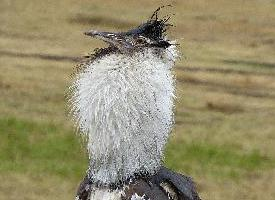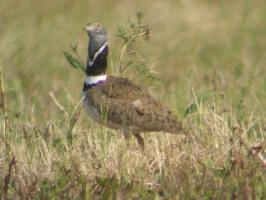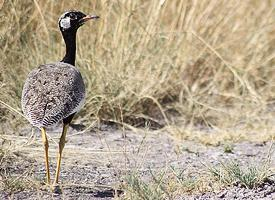
Poids et mesures
| Longueur | 1,2 m |
|---|---|
| Poids | 19 kg |
Description de l'animal
The Kori Bustard (Ardeotis kori) stands as one of the most majestic and fascinating birds in the avian kingdom, particularly noted for its significant size and striking appearance. Native to the grasslands and savannahs of Africa, this bird is the heaviest flying bird native to the continent and one of the heaviest in the world, with males significantly larger than females. An adult male Kori Bustard can reach up to 120 cm (47 inches) in height and weigh between 7 to 18 kg (15 to 40 pounds), while females are considerably smaller.The plumage of the Kori Bustard is an exquisite blend of colors and patterns, perfectly adapted to its savannah and grassland habitats. Its back and upper parts are predominantly gray and brown, intricately patterned with black and white, which aids in camouflage among the tall grasses. The underparts are lighter, usually white or cream, with black bands. A distinctive feature is its black crest, which lies flat on the back of its head but can be erected during courtship displays. The bird's neck is long and thick, supporting a relatively small head compared to its body. Its eyes are yellow or golden, with a penetrating gaze, and it has a strong, yellow bill.
Kori Bustards are omnivorous, with a diet that reflects the abundance or scarcity of resources in their environment. They consume a wide variety of food, including insects (such as locusts and beetles), lizards, small mammals, seeds, berries, and leaves. Their feeding strategy involves walking slowly and deliberately across the savannah, picking up food items with their strong bills.
One of the most remarkable aspects of the Kori Bustard's behavior is its breeding ritual. Males perform an elaborate display to attract females, which includes puffing up their necks to reveal a spectacular white throat, inflating a gular pouch beneath their bill, raising their tail and crest, and strutting around to showcase their size and plumage. This visual spectacle is often accompanied by a deep, booming call that can be heard from considerable distances.
Despite their size, Kori Bustards are capable of flight. They prefer walking but will take to the air with a running start, using their powerful legs to propel themselves. Once airborne, their flight is strong and steady, with deep, slow wingbeats. However, they are predominantly terrestrial and spend most of their time on the ground.
The Kori Bustard faces threats from habitat destruction and hunting. In some parts of Africa, they are hunted for food and for traditional medicine, while agricultural expansion and changes in land use reduce their natural habitat. Although they are currently listed as Near Threatened by the International Union for Conservation of Nature (IUCN), their populations are decreasing, highlighting the need for continued conservation efforts.
In conclusion, the Kori Bustard is a symbol of the African wilderness, embodying the beauty, resilience, and complexity of the continent's natural heritage. Its remarkable size, distinctive appearance, and intriguing behaviors make it one of the most interesting subjects of study and conservation in the avian world.
Animaux similaires
Nouvelles photos d'animaux
Top 10 des animaux
- Dolphin gull (Leucophaeus scoresbii)
- Diana monkey (Cercopithecus diana)
- Moustached guenon (Cercopithecus cephus)
- Galápagos tortoise (Geochelone nigra complex)
- Russian tortoise (Testudo horsfieldii)
- Japanese macaque (Macaca fuscata)
- Stone loach (Barbatula barbatula)
- Greek tortoise (Testudo graeca)
- Common flying dragon (Draco volans)
- Colossal squid (Mesonychoteuthis hamiltoni)


